Binary Pattern Dictionary Learning
We present a final step of image processing pipeline which accepts a large number of images, containing spatial expression information for thousands of genes in Drosophila imaginal discs. We assume that the gene activations are binary and can be expressed as a union of a small set of non-overlapping spatial patterns, yielding a compact representation of the spatial activation of each gene. This lends itself well to further automatic analysis, with the hope of discovering new biological relationships. Traditionally, the images were labelled manually, which was very time-consuming. The key part of our work is a binary pattern dictionary learning algorithm, that takes a set of binary images and determines a set of patterns, which can be used to represent the input images with a small error.
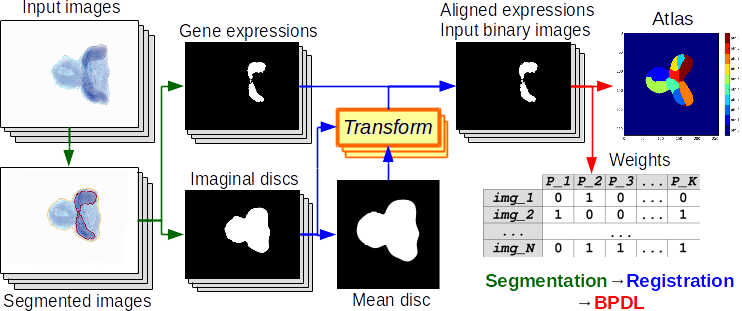
For the image segmentation and individual object detection, we used Image segmentation toolbox.
Comparable (SoA) methods
We have our method BPDL and also we compare it to State-of-the-Art, see Faces dataset decompositions:
- Fast ICA, derived from sklearn.decomposition.FastICA
- Sparse PCA, derived from sklearn.decomposition.SparsePCA
- Non-negative Matrix Factorisation, derived from sklearn.decomposition.NMF
- Dictionary Learning with Matching pursuit, derived from sklearn.decomposition.DictionaryLearning
- Spectral Clustering used in SPEX2, derived from sklearn.cluster.SpectralClustering
- CanIca & MSDL used for observing spatial activation in fMRI, derived from nilearn.decomposition.CanICA and nilearn.decomposition.DictLearning
- our Binary Pattern Dictionary Learning
Installation and configuration
Configure local environment
Create your local environment, for more see the User Guide, and install dependencies requirements.txt contains a list of packages and can be installed as
@duda:~$ cd pyBPDL
@duda:~/pyBPDL$ virtualenv env
@duda:~/pyBPDL$ source env/bin/activate
(env)@duda:~/pyBPDL$ pip install -r requirements.txt
(env)@duda:~/pyBPDL$ python ...
moreover, in the end, terminating…
(env)@duda:~/pyBPDL$ deactivate
Installation
The package can be installed via pip
pip install git+https://github.com/Borda/pyBPDL.git
alternatively, using setuptools from a local folder
python setup.py install
Data
We work on synthetic and also real images.
Synthetic datasets
We have script run_dataset_generate.py which generate a dataset with the given configuration. The images subsets are:
- pure images meaning they are generated just from the atlas
- noise images from (1) with added binary noise
- deform images from (1) with applied small elastic deformation
- deform&noise images from (3) with added binary noise
both for binary and fuzzy images. Some parameters like number of patterns and image size (2D or 3D) are parameters passed to the script Other parameters like noise and deformation ratio, are specified in the script.
python experiments/run_dataset_generate.py \
-p ~/DATA/apdDataset_vX \
--nb_samples 600 --nb_patterns 9 --image_size 128 128
Sample atlases
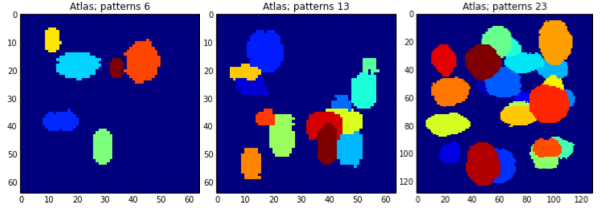
Sample binary images
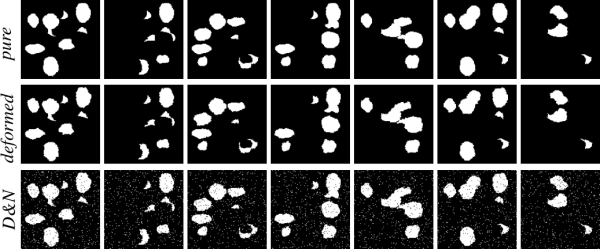
Sample fuzzy images
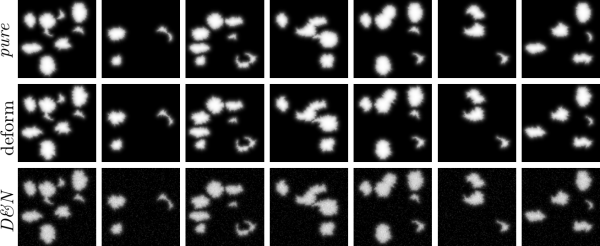
For adding Gaussian noise with given sigmas use following script:
python experiments/run_dataset_add_noise.py \
-p ~/Medical-drosophila/synthetic_data \
-d apdDataset_vX --sigma 0.01 0.1 0.2

Real images
We can use as input images, either binary segmentation or fuzzy values. For the activation extraction we used pyImSegm package.
Drosophila imaginal discs
For extracting gene activations, we used unsupervised segmentation because the colour is appearing variate among images, so we segment the gene in each image independently.
To cut the set of images to the minimal size with reasonable information (basically removing background starting from image boundaries) you can use the following script
python experiments/run_cut_minimal_images.py \
-i "./data_images/imaginal_discs/gene/*.png" \
-o ./data_images/imaginal_discs/gene_cut -t 0.001
Drosophila ovary
Here the gene activation is presented in the separate channel - green. So we just take this information and normalise it. Further, we assume that this activation is fuzzy based on intensities on the green channel.
python experiments/run_extract_fuzzy_activation.py \
-i "./data_images/ovary_stage-2/image/*.png" \
-o ./data_images/ovary_stage-2/gene
Ovary in development stage 2


Ovary in development stage 3
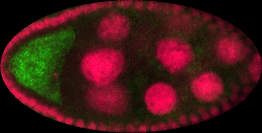

Experiments
We run an experiment for debugging and also evaluating performances.
To collect the results we use run_parse_experiments_result.py which visit all experiments and aggregate the configurations with results together into one large CSV file.
python run_parse_experiments_result.py \
-i ~/Medical-drosophila/TEMPORARY/experiments_APDL_synth \
--fname_results results.csv --func_stat mean
Binary Pattern Dictionary Learning
We run just our method on both synthetic/real images using run_experiment_apd_bpdl.py where each configuration have several runs in debug mode
(saving more log information and also exporting all partially estimated atlases)
- Synthetic datasets
python experiments/run_experiments.py \ --type synth --method BPDL \ -i ./data_images/syntheticDataset_vX \ -o ./results -c ./data_images/sample_config.yml \ --debug - Real images - drosophila
python experiments/run_experiments.py \ --type real --method BPDL \ -i ~/Medical-drosophila/TEMPORARY/type_1_segm_reg_binary \ -o ~/Medical-drosophila/TEMPORARY/experiments_APDL_real \ --dataset gene_small
Using configuration YAML file -cfg we can set several parameters without changing the code and parametrise experiments such way that we can integrate over several configurations. While a parameter is a list it is aromatically iterated, and you set several iterations, then it runs as each to each option, for instance
nb_labels: [5, 10]
init_tp: 'random'
connect_diag: true
overlap_major: true
gc_reinit: true
ptn_compact: false
ptn_split: false
gc_regul: 0.000000001
tol: 0.001
max_iter: 25
runs: 1
deform_coef: [null, 0.0, 1.0, 0.5]
will run 2 * 4 = 8 experiment - two numbers of patterns and four deformation coefficients.
All methods
We can run all methods in the equal configuration mode on given synthetic/real data using run_experiments_all.py running in info mode, just a few printing
- Synthetic datasets
python experiments/run_experiments.py \ -i ~/Medical-drosophila/synthetic_data/atomicPatternDictionary_v1 \ -o ~/Medical-drosophila/TEMPORARY/experiments_APDL_synth1 \ --method PCA ICA DL NMF BPDL - Real images - drosophila
python experiments/run_experiments.py --type real \ -i ~/Medical-drosophila/TEMPORARY/type_1_segm_reg_binary \ -o ~/Medical-drosophila/TEMPORARY/experiments_APD_real \ --dataset gene_small
Visualisations
Since we have a result in the form of estimated atlas and encoding (binary weights) for each image, we can simply see the back reconstruction
python experiments/run_reconstruction.py \
-e ./results/ExperimentBPDL_real_imaginal_disc_gene_small \
--nb_workers 1 --visual

Aggregating results
The result from multiple experiments can be simple aggregated into single CVS file
python experiments/run_parse_experiments_results.py \
--path ./results --name_results results.csv \
--name_config config.yaml --func_stat none
In case you need to add or change an evaluation you do not need to return all experiment since the aliases and encoding is done, you can just rerun the elevation phase generating new results results_NEW.csv
python experiments/run_recompute_experiments_result.py -i ./results
and parsing the new results
python experiments/run_parse_experiments_results.py \
--path ./results --name_results results_NEW.csv \
--name_config config.yaml --func_stat none
References
For complete references see bibtex.
- Borovec J., Kybic J. (2016) Binary Pattern Dictionary Learning for Gene Expression Representation in Drosophila Imaginal Discs. In: Computer Vision – ACCV 2016 Workshops. Lecture Notes in Computer Science, vol 10117, Springer, DOI: 10.1007/978-3-319-54427-4_40.